The Table of Content


Family Research:









Available Help:



|
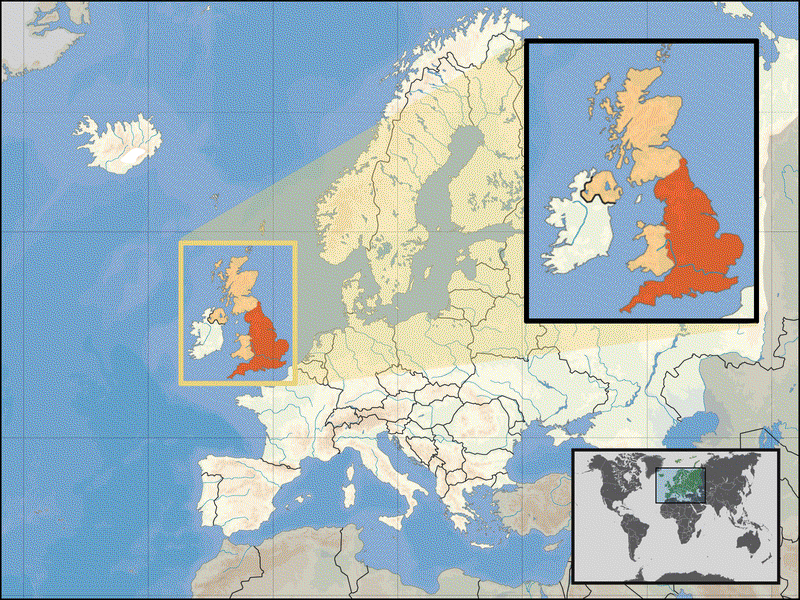
Since the Age of Discovery, which began during the 15th century, England has had a significant cultural and legal impact on the world. The English language, the Anglican Church, and English law—the basis for the common law legal systems of many other countries in the world. The Industrial Revolution began in 18th-century England, transforming its society into the world's first industrialized nation, and its Royal Society laid the foundations of modern experimental science.
Lowlands are common for English terrain, however there are uplands in the north (for example, the Lake District, Pennines, and Yorkshire Moors) and in the south and south west (for example, Dartmoor, the Cotswolds, and the North and South Downs). London, England's capital, is the largest metropolitan area in the United Kingdom and the largest urban zone in the European Union by most measures. England's population is about 51 million, around 84% of the population of the United Kingdom, and is largely concentrated in London, the South East and conurbations in the Midlands, the North West, the North East and Yorkshire, which developed as major industrial regions during the 19th century.
Geography
Landscape and rivers
Geographically England comprises the central and southern two-thirds of the island of Great Britain, plus such offshore islands as the and the Isles of Scilly. It is bordered by two fellow countries of the United Kingdom—to the north by Scotland and to the west by Wales. England is closer to the European Continent than any other part of mainland Britain. It is separated from France by a 34-kilometre (21 mi) sea gap, though the two countries are connected by the Channel Tunnel near Folkestone. As England is on an island, is it surrounded by the water of the Irish Sea, North Sea and Atlantic Ocean. The most important rivers in England, because of their ports of London, Liverpool, and Newcastle, are the tidal rivers Thames, Mersey and Tyne. The tides raise the level of water in their estuaries and enable ships to enter the ports. At 354 kilometres (220 mi), the Severn is the longest river flowing through England. It empties into the Bristol Channel and is notable for its Severn Bore tidal waves, which can reach 2 metres (6.6 ft) in height. However, the longest river entirely in England is the Thames, which is 346 kilometres (215 mi) in length. There are many lakes in England but the majority are in the aptly named Lake District; the largest of which is Lake Windermere, it is known by the nickname "Queen of Lakes".

Cliffs of Clovelly Coast, North Develon
In geological terms, the Pennines, known as the "backbone of England", are the oldest range of mountains the country, originating from the end of the Paleozoic Era around 300 million years ago. The total length of the Pennines is 400 kilometres (250 mi), peaking at Cross Fell in Cumbria. The material of which they are composed is mostly sandstone and limestone, but also coal. There are karst landscapes in calcite areas such as parts of Yorkshire and Derbyshire. The Pennine landscape is high moorland in upland areas, indented by fertile valleys of the region's rivers. They contain three national parks, the Yorkshire Dales, Northumberland, and the Peak District. The highest point in England, at 978 metres (3,210 ft), is Scafell Pike in Cumbria. Straddling the border between England and Scotland are the Cheviot Hills. The English Lowlands are to the south of the Pennines, consisting of green rolling hills, including the Cotswold Hills, Chiltern Hills, North and South Downs—where they meet the sea they form white rock exposures such as the cliffs of Dover. The granitic Southwest Peninsula in the West Country provides upland moorland, such as Dartmoor and Exmoor, which flourish with a mild climate; both are national parks.
Climate
England has a temperate maritime climate meaning that it is mild with temperatures not much lower than 0 °C (32 °F) in winter and not much higher than 32 °C (90 °F) in summer. The weather is damp relatively frequently and is subject to change. The coldest months are January and February, the latter particularly on the English coast, while July is normally the warmest month. Months with mild to warm weather with least rainfall are May, June, September and October. The biggest influences on the climate of England comes from the proximity to the Atlantic Ocean, its northern latitude and warming of the waters around the Gulf Stream. England receives quite a significant proportion of rainfall during the year, with autumn and winter being the wettest time—geographically the Lake District receives more rain than anywhere else in the country. Since weather recording records began, the highest temperature received was 38.5 °C (101.3 °F) on 10 August 2003 at Brogdale in Kent, while the lowest was −26.1 °C (−15 °F) on 10 January 1982 in Edgmond, Shropshire.
| Weather data for England |
|---|
| | Jan | Feb | Mar | Apr | May | Jun | Jul | Aug | Sep | Oct | Nov | Dec | Year |
|---|
| Average high (°F) | 45 | 45 | 48 | 54 | 59 | 64 | 70 | 70 | 64 | 57 | 50 | 45 | 55 |
|---|
| Average low (°F) | 34 | 34 | 36 | 39 | 43 | 48 | 52 | 52 | 48 | 45 | 39 | 36 | 43 |
|---|
| Precipitation (inches) | 3.31 | 2.36 | 2.64 | 2.24 | 2.2 | 2.48 | 2.13 | 2.64 | 2.87 | 3.31 | 3.31 | 3.54 | 32.99 |
|---|
| Source: Met Office 19 February 2008 |
Major Areas
The Greater London Urban Area is by far the largest metropolitan area in England and one of the busiest cities in the world. It is considered a global city and has a population larger than other countries in the United Kingdom besides England itself. Other urban areas of considerable size and influence tend to be in northern England or the English Midlands. There are fifty settlements which have been designated city status in England, while the wider United Kingdom has sixty-six. While many cities in England are quite large in size, such as Birmingham, Manchester, Liverpool, Leeds, Newcastle, Bradford, Nottingham and others, a large population is not necessarily a prerequisite for a settlement to be afforded city status. Traditionally the status was afforded to towns with diocesan cathedrals and so there are smaller cities like Wells, Ely, Ripon, Truro and Chichester. According to the Office for National Statistics the ten largest, continuous built-up urban areas are:
| Rank | Urban Area | Number
People
| Localities | Major Localities | | 1. | Greater London | 8,278,251 | 67 | Greater London, divided into the City of London and 32 London boroughs including Croydon, Barnet, Ealing, Bromley | | 2. | West Midlands | 2,284,093 | 22 | Birmingham, Wolverhampton, Dudley, Walsall | | 3. | Greater Manchester | 2,240,230 | 57 | Manchester, Salford, Bolton, Stockport, Oldham | | 4. | West Yorkshire | 1,499,465 | 26 | Leeds, Bradford, Huddersfield, Wakefield | | 5. | Tyneside | 879,996 | 25 | Newcastle, North Shields, South Shields, Gateshead, Jarrow | | 6. | Liverpool | 816,216 | 8 | Liverpool, St Helens, Bootle, Huyton-with-Roby | | 7. | Nottingham | 666,358 | 15 | Nottingham, Beeston and Stapleford, Carlton, Long Eaton | | 8. | Sheffield | 640,720 | 7 | Sheffield, Rotherham, Chapeltown, Mosborough | | 9. | Bristol | 551,066 | 7 | Bristol, Kingswood, Mangotsfield, Stoke, Gifford | | 10. | Brighton, Worthing & Littlehampton | 461,181 | 10 | Brighton, Worthing, Hove, Littlehampton, Shoreham, Lancing |
Economy
England's economy is one of the largest in in the world, with an average GDP per capita of £22,907. Usually regarded as a mixed market economy, it has adopted many free market principles in contrast to the Rhine Capitalism of Europe, yet maintains an advanced social welfare infrastructure. The official currency in England is the pound sterling, also known as the GBP. Taxation in England is quite competitive when compared to much of the rest of Europe—as of 2009 the basic rate of personal tax is 20% on taxable income up to £37,400, and 40% on any additional earnings above that amount. The economy of England is the largest part of the UK's economy, which has the 18th highest GDP PPP per capita in the world. England is a leader in the chemical and pharmaceutical sectors and in key technical industries, particularly aerospace, the arms industry, and the manufacturing side of the software industry. London, home to the London Stock Exchange, the UK's main stock exchange and the largest in Europe, is England's financial centre—100 of Europe's 500 largest corporations are based in London. London is the largest financial centre in Europe, and as of 2009 is also the largest in the world.
The Bank of England, founded in 1694 by Scottish banker William Paterson, is the UK's central bank. Originally instituted to act as private banker to the Government of England, it carried on in this role as part of the United Kingdom—since 1946 it has been a state-owned institution. The Bank has a monopoly on the issue of banknotes in England and Wales, although not in other parts of the United Kingdom. Its Monetary Policy Committee has devolved responsibility for managing the monetary policy of the country and setting interest rates. England is highly industrialized, but since the 1970s there has been a decline in traditional heavy and manufacturing industries, and an increasing emphasis on a more service industry oriented economy. Tourism has become a significant industry, attracting millions of visitors to England each year. The export part of the economy is dominated by pharmaceuticals, automobiles—although many English marquees are now foreign-owned, such as Rolls-Royce, Lotus, Jaguar and Bentley—crude oil and petroleum from the English parts of North Sea Oil along with Wytch Farm, aircraft engines and alcoholic beverages. Agriculture is intensive and highly mechanized, producing 60% of food needs with only 2% of the labor force. Two thirds of production is devoted to livestock, the other to arable crops.
Infrastructure
The Department for Transport is the government body responsible for overseeing transport in England. There are several motorways in England, one of the most important trunk roads is the A1 Great North Road, stretching across the country from London to Newcastle. The longest motorway in England is the M6, stretching from Rugby to the North West up to the Anglo-Scottish border. There are other major roads; the M1 from London to Leeds, the M25 which encircles London, the M60 which encircles Manchester, the M4 from London to South Wales, the M62 from Liverpool to Manchester and East Yorkshire and the M5 from Birmingham to Bristol and the South West. Bus transport across the country is common, major companies include National Express, Arriva and Go-Ahead Group. The red double-decker buses in London have become a symbol of England. There is a rapid rail network in two English cities; the London Underground and the Tyne and Wear Metro, the latter in Newcastle, Gateshead and Sunderland. There are tram networks, such as; Blackpool, Manchester Metrolink, Sheffield Supertram and Midland Metro.
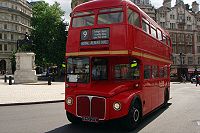 
| Red double-decker | | The Auston Martin |
Rail transport in England is the oldest in the world, with the system originating there in 1825. Much of Britain's 16,116 kilometres (10,014 mi) of rail network lies in England, covering the country extensively. These lines are mostly single, double or quadruple track, though there are narrow gauge lines. There is rail transport access to France and Belgium through an undersea rail link, the Channel Tunnel which was completed in 1994. There are air transport facilities in England connected the public to numerous international locations, the largest airport is London Heathrow Airport which in terms of passenger volume in the busiest in Europe and one of busiest in the world. Other large airports include Manchester Airport, London Stansted Airport, Luton Airport and Birmingham International Airport. By sea there is ferry transport, both for internal and external trips, some of the most common links are to Ireland, the Netherlands and Belgium. Travel by waterways such as rivers, canals, docks is common with around 7,100 km (4,400 mi) of navigable waterways in England, half of which is owned by British Waterways. The Thames is the major waterway in England, with imports and exports focused at the Port of Tilbury, one of the UK's three major ports.
The National Health Service (NHS) is the publicly funded healthcare system in England responsible for providing the majority of healthcare in the country. The NHS began on 5 July 1948, putting into effect the provisions of the National Health Service Act 1946. It was based on the findings of the Beveridge Report, prepared by economist and social reformer William Beveridge. The NHS is largely funded from general taxation including National Insurance payments, it provides most services at no additional cost though there are extra charges associated with eye tests, dental care, prescriptions and aspects of personal care. The government department responsible for the NHS is the Department of Health, headed by the Secretary of State for Health, who sits in the British Cabinet. Most of the expenditure of the Department of Health is spent on the NHS—£98.6 billion was spent in 2008–2009. In recent years the private sector has been increasingly used to provide more NHS services despite opposition by doctors and trade unions. The average life expectancy of people in England is 77.5 years for males and 81.7 years for females, the highest of the four countries of the United Kingdom.
Demography
With over 51 million inhabitants, England is the most populous country of the United Kingdom, accounting for 84% of the combined total. England taken as a unit and measured against international states has the fourth largest population in the European Union and would be the 25th largest country by population in the world. With a density of 395 people per square kilometer, it would be the second most densely populated country in the European Union after Malta. The English people are a British people —genetic evidence suggests that 75–95% descend in the paternal line from prehistoric settlers who originally came from the Iberian Peninsula. There is a significant Norse element, as well as a 5% contribution from Angles and Saxons, though other geneticists place the Norse- Germanic estimate up to half. Over time various cultures have been influential — Prehistoric, Brythonic, Roman, Anglo-Saxon, Norse and Gaelic cultures, as well as a large influence from Normans. There is an English Diaspora in former parts of the British Empire; especially the United States, Canada, Australia, Chile, South Africa and New Zealand. Since the late 1990s, English people have migrated to Spain.
At the time of the Doomsday Book, compiled in 1086, more than 90% of the English population of about two million lived in the countryside. By 1801 the population had grown to 8.3 million, and by 1901 had grown to 30.5 million. Due to the economic prosperity in South East England there are many economic migrants from the other parts of the United Kingdom. There has been significant Irish migration, with 25% of English people having Irish ancestry. The European population totals at 89.90%, including Germans and Poles. Other people from much further afield in the former British colonies have arrived since the 1950s—5.30% of people living in England have migrated from the Indian subcontinent, mostly India and Pakistan. 2.30% of the population are black, mostly from the Caribbean. There is a significant number of Chinese and British Chinese. As of 2007, 22% of primary school children in England were from ethnic minority families. About half of the population increase between 1991–2001 was due to foreign-born immigration. Debate over immigration is politically prominent, according to a Home Office poll 80% of people want to cap it. The ONS has projected that the population will grow by six million between 2004 and 2029.
Language
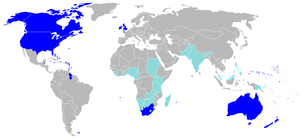
The English-speaking world. Countries in dark blue have a majority of native speakers. Countries in light blue have English as an official language, de jure or de facto. English is also one of the official languages of the European Union.
As its name suggests, the English language, today spoken by hundreds of millions of people around the world, originated as the language of England, where it remains the principal tongue today. An Indo-European language in the Anglo-Frisian branch of the Germanic family, it is closely related to Scots. After the Norman conquest, the Old English language was displaced and confined to the lower social classes as Norman French and Latin were used by the aristocracy. By the 17th century, English came back into fashion among all classes, though much changed; the Middle English form showed many signs of French influence, both in vocabulary and spelling. During the English Renaissance, many words were coined from Latin and Greek origins. Modern English has extended this custom of flexibility, when it comes to incorporating words from different languages. Thanks in large part to the British Empire, the English language is the world's unofficial lingua franca.
English language learning and teaching is an important economic activity, and includes language schooling, tourism spending, and publishing. There is no legislation mandating an official language for England, but English is the only language used for official business. Despite the country's relatively small size, there are many distinct regional accents, and individuals with particularly strong accents may not be easily understood everywhere in the country. Cornish, which died out as a community language in the 18th century, is being revived, and is now protected under the European Charter for Regional or Minority Languages. It is spoken by 0.1% of people in Cornwall, and is taught to some degree in several primary and secondary schools. State schools teach students a second language, usually French, German or Spanish. Due to immigration, it was reported in 2007 that around 800,000 school students spoke a foreign language at home, the most common being Punjabi and Urdu.
Education
Universities and learning institutions
The body responsible for state education in general up to the age of 19, in the United Kingdom is the Department for Children, Schools and Families —this body directly controls state schools in England. Funded through taxation state-run schools are attended by approximately 93% of English schoolchildren. There is a minority of faith schools, mostly Church of England or Catholic Church. Between three and four is nursery school, four and eleven is primary school, and eleven to sixteen is secondary school, with an option for a two-year extension to attend sixth form college. Although most English secondary schools are comprehensive, there are selective intake grammar schools, to which entrance is subject to passing the eleven plus exam. Around 7.2% of English schoolchildren attend private schools which are funded by private sources. Standards are monitored by regular inspections of state-funded schools by the Office for Standards in Education and of private schools by the Independent Schools Inspectorate.
After finishing compulsory education, pupils take a GCSE examination, following which they may decide to continue in further education and attend a further education college. Students normally enter universities in the United Kingdom from 18 onwards, where they study for an academic degree. England has more than 90 state-funded universities, which are monitored by the Department for Innovation, Universities and Skills. Students are generally entitled to student loans for maintenance. The first degree offered to undergraduates is the Bachelor's degree, which usually takes three years to complete. Students are then eligible for a postgraduate degree, a Master's degree, taking one year, or a Doctorate degree, which takes three. England has a history of promoting education, and its top institutions are internationally respected. The most acclaimed English universities are Oxford and Cambridge. These two "ancient universities" have many common features and are nowadays known as Oxbridge. The King's School, Canterbury and The King's School, Rochester are the oldest schools in the English-speaking world. Many of England's more well-known schools, such as Winchester College, Eton College, St Paul's School, Rugby School, and Harrow School are fee-paying institutions.
Prominent English figures from the field of science and mathematics include Sir Isaac Newton, Michael Faraday, Charles Darwin, Stephen Hawking, Christopher Wren, Alan Turing, Francis Crick, Joseph Lister, Tim Berners-Lee, Andrew Wiles and Richard Dawkins. Experts claim that the earliest concept of a metric system was invented by John Wilkins, first secretary of the Royal Society in 1668. As birthplace of the Industrial Revolution, England was home to many significant inventors during the late 18th and early 19th century. Famous English engineers include Isambard Kingdom Brunel, best known for the creation of the Great Western Railway, a series of famous steamships, and numerous important bridges, hence revolutionizing public transport and modern-day engineering.
Inventions and discoveries of the English include; the first industrial spinning machine, the first computer and the first modern computer, the World Wide Web along with HTTP and HTML, the first successful human blood transfusion, the vacuum cleaner, the lawnmower, the seat belt, the hovercraft, the electric motor, the microphone, steam engines, and theories such as the Darwinian theory of evolution and atomic theory. Newton developed the ideas of universal gravitation, Newtonian mechanics, and infinitesimal calculus, and Robert Hooke his eponymously named law of elasticity. Other inventions include the iron plate railway, the thermosiphon, tarmac, the rubber band, the mousetrap, "cat's eye" road safety device, joint development of the light bulb, steam locomotives, the seed drill, the jet engine and many modern techniques and technologies used in precision engineering.
Religion
Christianity is the most widely practiced religion in England, as it has been since the Early Middle Ages, although it was first introduced much earlier, in Gaelic and Roman times. It continued through Early Insular Christianity, and today about 71.6% of English people identify as Christians. The largest form practiced in the present day is Anglicanism, dating from the 16th century Reformation period, with the 1536 split from Rome over Henry VIII wanting to divorce Catherine of Aragon, the religion regards itself as both Catholic and Reformed. There are High Church and Low Church traditions, and some Anglicans regard themselves as Anglo-Catholics, after the Tractarian movement. The monarch of the United Kingdom is the head of the Church, acting as its Supreme Governor. It has the status of established church in England. There are around 26 million adherents to the Church of England and they form part of the Anglican Communion with the Archbishop of Canterbury acting as the symbolic worldwide head. Many cathedrals and parish churches are historic buildings of significant architectural importance, such as Westminster Abbey, York Minster, Durham Cathedral and Salisbury Cathedral.
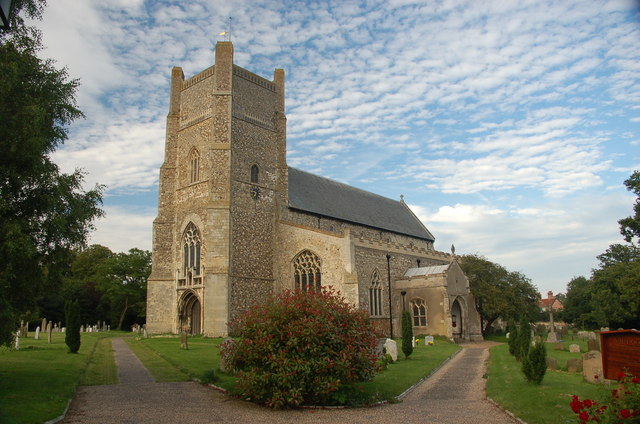
Church of St Bartholomew, Orford
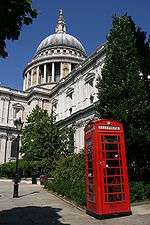 .jpg) 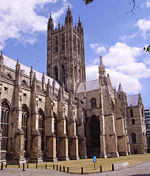
| St. Paul Cathedral | | Christ Church at Oxford | | Westminster Abby |
The second largest Christian practice is the Latin Rite of the Catholic Church, which traces its formal, corporate history in England to the 6th century with Augustine's mission and was the main religion on the entire island for around a thousand years. Since its reintroduction after the Catholic Emancipation, the Church has organized ecclesiastically on an England and Wales basis where there are 4.5 million members (most of whom are English). There has been one Pope from England to date, Adrian IV; while saints Bede and Anslem are regarded as Doctors of the Church. A form of Protestantism known as Methodism is the third largest and grew out of Anglicanism through John Wesley. It gained popularity in the mill towns of Lancashire and Yorkshire, and amongst tin miners in Cornwall. There are other non-conformist minorities, such as Baptists, Quakers, Congregationalists, Unitarians and the Salvation Army. are non-Christian religions practiced. Jews have a history of a small minority on the island since 1070. They were expelled from England in 1290 following the Edict of Expulsion, only to be allowed back in 1656. Especially since the 1950s Eastern religions from the former British colonies have began to appear, due to foreign immigration; Islam is the most common of these accounting for around 3.1% in England. Hinduism, Sikhism and Buddhism are next in number adding up to 2% combined, introduced from India and South East Asia. Around 14.6% claim to have no religion. Prior to the rise of Christianity—Celtic, Roman, Anglo-Saxon and Norse mythology was practiced.
Culture
Architecture
Many ancient standing stone monuments were erected during the prehistoric period, amongst the best known are Stonehenge, Devil's Arrows, Rudston Monolith and Castlerigg. With the introduction of Ancient Roman architecture there was a development of basilicas, baths, amphitheaters, triumphal arches, villas, Roman temples, Roman roads, Roman forts, stockades and aqueducts. It was the Romans who founded the first cities and towns such as London, Bath, York, Chester and St Albans. Perhaps the best known example is Hadrian's Wall stretching right across northern England. Another well preserved example is the Roman Baths at Bath, Somerset. Early Medieval architecture's secular buildings were simple constructions mainly using timber with thatch for roofing. Ecclesiastical architecture ranged from a synthesis of Hiberno—Saxon monasticism, to Early Christian basilica and architecture characterized by pilaster-strips, blank arcading, baluster shafts and triangular headed openings. After the Norman conquest in 1066 various Castles in England were created so law lords could uphold their authority and in the north to protect from invasion. Some of the best known medieval castles include the Tower of London, Warwick Castle, Durham Castle and Windsor Castle amongst others.
Throughout the Plantagenet era an English Gothic architecture flourished—the medieval cathedrals such as Canterbury Cathedral, Westminster Abbey and York Minster are prime examples. Expanding on the Norman base there was also castles, palaces, great houses, universities and parish churches. Medieval architecture was completed with the 16th century Tudor style; the four-centered arch, now known as the Tudor arch, was a defining feature as were wattle and daub houses domestically. In the aftermath of the Renaissance a form of architecture echoing classical antiquity, synthesized with Christianity appeared—the English Baroque style, architect Christopher Wren was particularly championed. Georgian architecture followed in a more refined style, evoking a simple Palladian form; the Royal Crescent at Bath is one of the best examples of this. With the emergence of romanticism during Victorian period, a Gothic Revival was launched—in addition to this around the same time the Industrial Revolution paved the way for buildings such as The Crystal Palace. Since the 1930s various modernist forms have appeared whose reception is often controversial, though traditionalist resistance movements continue with support in influential places.
Folklore
English folklore developed over many centuries. Some of the characters and stories are present across England, but most belong to specific regions. Common folkloric beings include pixies, giants, elf's, bogeymen, trolls, goblins and dwarves. While many legends and folk-customs are thought to be ancient, for instance the tales featuring Offa of Angeln and Weyland Smith, others date from after the Norman invasion; Robin Hood and his Merry Men of Sherwood and their battles with the Sheriff of Nottingham being, perhaps, the best known. During the High Middle Ages tales originating from Brythonic traditions entered English folklore—the Arthurian myth. These were derived from Anglo-Norman, French and Welsh sources, featuring King Arthur, Camelot, Excalibur, Merlin and the Knights of the Round Table such as Lancelot. These stories are most centrally brought together within Geoffrey of Monmouth's Historia Regum Britanniae. Another early figure from British tradition, King Cole, may have been based on a real figure from Sub-Roman Britain. Many of the tales and pseudo-histories make up part of the wider Matter of Britain, a collection of shared British folklore.
 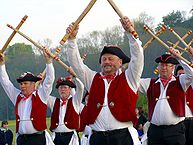
Some folk figures are based on semi or actual historical people whose story has been passed down centuries; Lady Godiva for instance was said to have ridden naked on horseback through Coventry, Hereward the Wake was a heroic English figure resisting the Norman invasion, Herne the Hunter is an equestrian ghost associated with Windsor Forest and Great Park and Mother Shipton is the archetypal witch. On 5 November people make bonfires, set off fireworks and eat toffee apples in commemoration of the Gunpowder Plot centered around Guy Fawkes. The chivalrous bandit, such as Dick Turpin, is a recurring character, while Blackbeard is the archetypal pirate. There are various national and regional folk activities, participated in to this day, such as Morris dancing, Maypole dancing, Rapper sword in the North East, Long Sword dance in Yorkshire, Mummers Plays, bottle-kicking in Leicestershire, and cheese-rolling at Cooper's Hill. There is no official national costume, but a few are well established such as the Pearly Kings and Queens associated with cockneys, the Royal Guard, the Morris costume and Beefeaters.
  
|








.jpg)




